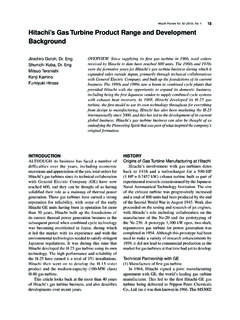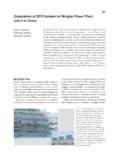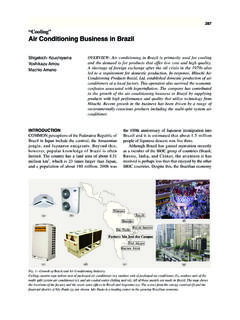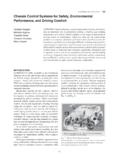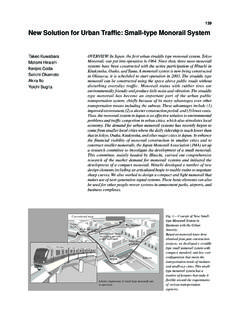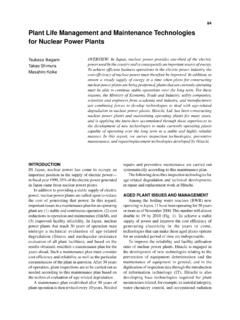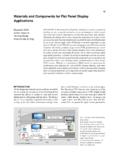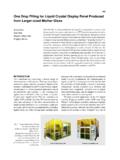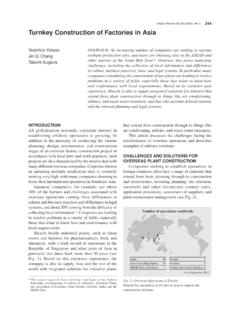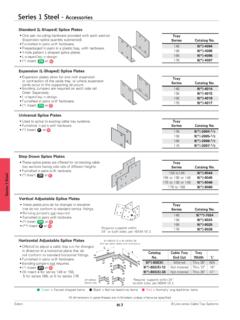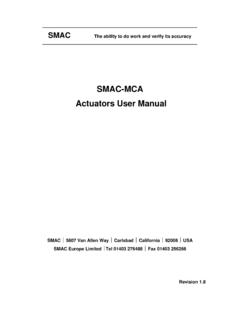Transcription of Development of 22-kV Distribution Systems and …
1 Development of 22 kV Distribution Systems and switchgear 158 Development of 22-kV Distribution Systems andSwitchgearOVERVIEW: As the demand for power has continued to grow in cities andother areas of concentrated power consumption, costs are rising due to thelack of sites to locate 6-kV Distribution substations and increasinglycongested Distribution conduits. This has led to a demand for power supplysystems and equipment that can boost Distribution per line capacity from 6kV to 22 kV, that can deliver loads close to where the power is consumed,and minimize power losses in Distribution which reduces CO2 emissionsand thus helps mitigate global warming.
2 Standing in the way of greaterdeployment of 22-kV switchgear is that the equipment is larger and morecostly than prevailing 6-kV equipment. To address this situation, Hitachi,Ltd. joined forces with The Tokyo Electric Power Co., Inc. to develop morecompact and less expensive 22-kV Distribution KikukawaKenji TsuchiyaSatoru KajiwaraAkira TakahamaINTRODUCTIONALTHOUGH the availability of 6-kV Distribution inurban centers and other areas of concentrated demandfor power is quite high, the prospect of boosting 6-kVsupply further is fraught with difficulties: it has becomeextremely difficult to acquire sites for locating newpower Distribution substation due to rising land pricesand it has become harder to secure Distribution routesbecause power Distribution conduits are alreadycongested.
3 On the other hand, most of Japan s powerdistribution infrastructure in urban areas isunderground, so if excavation work is done to lay newFig. 1 Overview of 22-kV Distribution , which is inversely proportional to voltage, is substantially lower for 22-kV Distribution than forconventional 6-kV Distribution when the amount of power used is the same. In addition, 22-kV Systems give offless CO2 emissions since energy losses during Distribution are proportional to current squared, so 22-kVdistribution also helps reduce global line400 V/100 200 V transformerPMT: pad-mounted transformer.
4 Often installed on the sidewalk. RNW: regular network. By interconnecting several RNWs on the low-voltage side, load can continue to be supplied from another system in the event one system fails. SNW: spot network. A spot network consists of the secondaries of three transformers connected together to maintain a constant source of supply even if one transformer fails. 22 kV/400 Vtransformer22 kV/6 kV transformer100 V/200 V230 V/400 V400 V22 kV22 kV6 kV400 V400 VLess than 50 kW(residence)50 500 kW(small building)500 2,000 kW(medium building)2,000 10,000 kW(large building)6-kVdistribution lineMini substationBranchcabinetPMTB ranchcabinetRNW Transformercabinet22-kVdistribution lineSNW Substation66 kV/22 kVHitachi Review Vol.
5 53 (2004), No. 3 159secondaries of two or more transformers and thereforecontinue to supply power even when one line is downfor inspection, and have a high degree of maintainabilityand are generally deployed as low-voltageSNWs in which transformer secondaries supply low-voltage power or as high-voltage SNWs in whichtransformer secondaries supply 6 kV to supportefficient Distribution within a single building (see ).(3) RNW*2 systemsRNW Systems maintain a constant source of supplyand are generally applied in bustling shopping areassuch as Ginza and Shinjuku in Tokyo.
6 However, thissystem is not being expanded because of the numerousrequests from customers for 6-kV power and becausethe system is insufficient in maintainability, operability,Fig. 2 Schematic Single-line Connection for for main and backup line system (a) and SNWsystem (b).: Switch: Transformer: Circuit breaker22-kV Distribution line(a)(b) 22-kV Distribution linesMain lineBackup linedistribution feeders, it makes much more economicsense to deploy 22-kV Distribution lines that have aboutthree times the capacity of 6-kV lines. At the sametime we must keep in mind the need for existingsubstations to make effective use of 22-kV equipmentand the need to maintain efficient supply throughcentralized control of 6-kV Distribution Systems andpower primary obstacles standing in the way of furtherdeployment of 22-kV Distribution is that thisequipment is larger and more costly than comparable6-kV Systems .
7 Challenged to address this situation,Hitachi, Ltd. entered into an alliance with The TokyoElectric Power Co., Inc. to develop and deploy morecompact and less costly 22-kV Distribution this paper we highlight the main features andapplications of the Systems that emerged from this jointresearch initiative; specifically, a 22-kV distributionsystem, hybrid switchgear , 22-kV /6-kV large-capacitymini substations, 3 N connection transformer (three-phase three-wire single-phase division connection),and 22-kV PMT (pad-mounted transformer) (see ). 22-kV Distribution SYSTEMThe 22-kV Distribution is primarily directed aturban and other densely populated areas, and ourefforts are focused on reducing overall costs (bymaking the equipment more compact and reducingequipment costs)
8 , by enhancing the Distribution systemto ensure improved reliability and better optimize the Distribution efficiency fromsubstations, 22-kV power may be distributed to thepoint of demand where it is stepped down to 6 kV, orin other cases such as industrial zones and sparselypopulated regions, power may be supplied by 6-kVdistribution Systems . Let us first consider the 22-kVsupply side equipment that is currently available1). 22-kV /Low Voltage Direct Supply(1) Main and backup line system and loop systemsThis is the most common system for receiving 22-kV power.
9 Since it has somewhat smaller transformercapacity than SNWs (spot networks)*1, it is moreeconomical both in terms of space and cost, and istherefore extensively deployed (see Fig. 2).(2) SNW systemsSNWs are most commonly found in cities and otherareas of high demand, and are seeing increasingdeployment to exploit their advantages: SNWsmaintain a constant sources of supply, consist of*1 SNW: spot network. A spot network consists of the secondaries ofthree transformers connected together to maintain a constant source ofsupply even if one transformer fails.
10 *2 RNW: regular network. By interconnecting several RNWs on the low-voltage side, load can continue to be supplied from another system in theevent one system of 22 kV Distribution Systems and switchgear 160conductor for connecting to the cable head at thebottom of the molded case, a current transformer formetering that is built into the epoxy molded insulatedhousing, a condenser for voltage detection, and three(for three phases) four-position vacuum switchesenclosed in a molded case (see Fig. 5).Insulation between the vacuum switches isaccomplished by a small amount of SF6 gas in theand SupplyA Distribution system has been supplied in which22 kV is distributed fairly close to customers, thenstepped down to 6 kV using a local mini we will describe the main/backup line system (mini substation).
